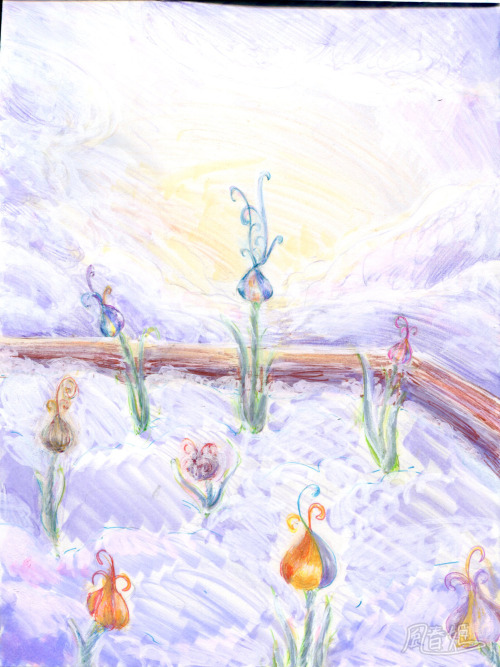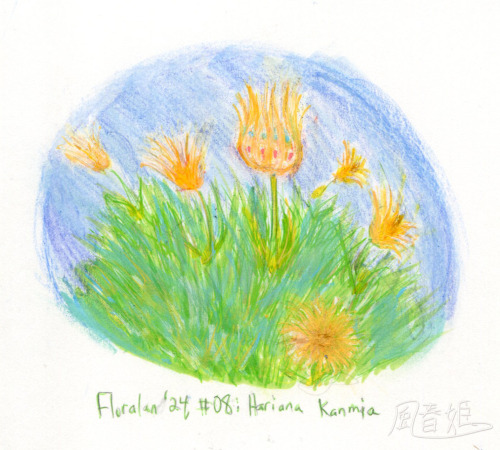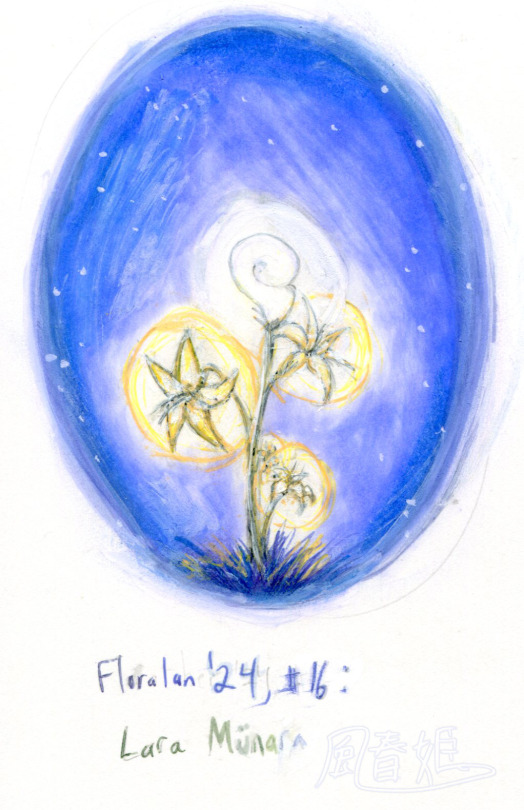Twis-tia Petalia

Twis-tia Petalia
Twis-tia Petalias were a once wild flowers that have been cultivated to grow in all sorts of different colors. The flower produces a nectar that hardens when exposed to air, producing a hard-candy-like substance within its flowers. The Twis-tia Petalia's close relative, the Sweetea Bundalia, does something similar, but has been cultivated to produce a hardening chocolate-like nectar instead of the honey-like substance that Twis-tia Petalias produce. As efforts to increase the number of Twis-tia Petalia and Sweetea Bundalia in JI continue, their delicious fruits can be expected to spread around JI as well.
-
 thehardestwater liked this · 1 year ago
thehardestwater liked this · 1 year ago -
 scribbly-bear liked this · 1 year ago
scribbly-bear liked this · 1 year ago -
 meadow-reblogs reblogged this · 1 year ago
meadow-reblogs reblogged this · 1 year ago -
 ciscandocinza liked this · 1 year ago
ciscandocinza liked this · 1 year ago -
 meadow-roses liked this · 1 year ago
meadow-roses liked this · 1 year ago -
 toothpaste-dragon liked this · 1 year ago
toothpaste-dragon liked this · 1 year ago -
 iggyfing liked this · 1 year ago
iggyfing liked this · 1 year ago
More Posts from Kazeharuhime

Heleh Lifurloa
If the Clera Fula signifies the start of the rainy season, the Heleh Lifurloa signifies the end. Its root system works tirelessly to help drain the land and stabilize the ground in the wake of the rainy season. In the dry months, however, it's nowhere to be seen. By what process it disappears has yet to be directly observed, but in particularly wet years when the Heleh Lifurloas are far and few in between, they are sometimes seen all year round, vanishing only when the ground around it is sufficiently drained.
It has long, string-like sticky pistils with which to collect wind-blown pollen as Heleh Lifurloas tend not to grow close together. It stores water in its stem, leaves, petals and tubers, which, aside from the petals, all share a glassy appearance. The leaves and tubers swell the more water they collect and shrink as the plant uses it up. The tubers can be shaped to create beautiful, decorative pieces. The leaves and stems are not so easily manipulated, but nevertheless make elegant, decorative pieces if caught before their mysterious disappearance.
The corolla is sometimes plucked to be used as a decorative container, similar to a Jara Flora. The nectar is used to sweeten tea themed around the flower during the Tea Festival. The leaves, stem and tubers can be melted and boiled down to create a slightly sweet syrup as well, but as the initial melted plant is full of water, it usually takes quite a while to boil it down to a syrup, and few parts of the plant are edible without processing. The pistils are trimmed and used to add a sweet, herbal note to tea themed around the plant.

Higehige Plant
A houseplant domesticated in Reline Ah, the Higehige Plant was first discovered as a wild vine that grew along the ground. With a little care, it came to be cultivated indoors. As Reline Ah can be rather rainy, watering it is often as easy as setting the flowerpot outside for a bit. Due to the long dry seasons in northern Wing Alayna, it never quite took off there, and remains to be something enjoyed only by the resident Flower Buddys of Reline Ah.

Magna Submariana
There is currently only one known specimen of the Magna Submariana, and it exists in the Great Buddy Lake. It is thought to be as old as the lake itself and to hold some great significance to it. Though its role is not fully understood, its other name is Magna Cortiana, and historical records refer to it as "The Heart of the Great Buddy Lake." Locals revere it and dare not touch it, believing calamity may befall the lake were anything to happen to the Magna Submariana deep within it.

Hariana Kanmia
The Hariana Kanmia is said to be the origin of all the other Hariana species, including Hariana Stratasa (featured here around the Hariana Kanmia). There is only one known Kanmia, and similar to how the Magna Subariana is thought to be the heart of the Great Buddy Lake, the Kanmia is thought to be the heart of all other Harianas, and if something were to befall it, calamity would befall the entire genus. This is of course speculation, but it keeps the lone specimen protected from careless Kitonyas, Neonyas, and children nonetheless.
The Hariana Kanmia can be found only in Fuline Ah, deep in the continent in a field of other Hariana species, such as plain Harianas, Stratasas and Blosomas.

Lara Münara
A relative of the Münlala Spikalif and Orbitania, the Lara Münara boasts of larger flowers than the latter and more Lar-like fruit than the former. The taste of its stem is distinctly plant-like, though it tastes slightly like that of an Omu-omu Plantai as well. The flowers make wonderful decorations, but are generally not used for more than decoration or garnish in when it comes to eating. They don't taste bad, but they don't have much a taste to speak of either.
The fruit is similar to that of the Münlala Spikalif and the Orbitania, but with less of a downy layer to it and a little more of a glass-like crunch to it. If it grew any closer to the mainland, it's possible the fruit would display more transparency as well.